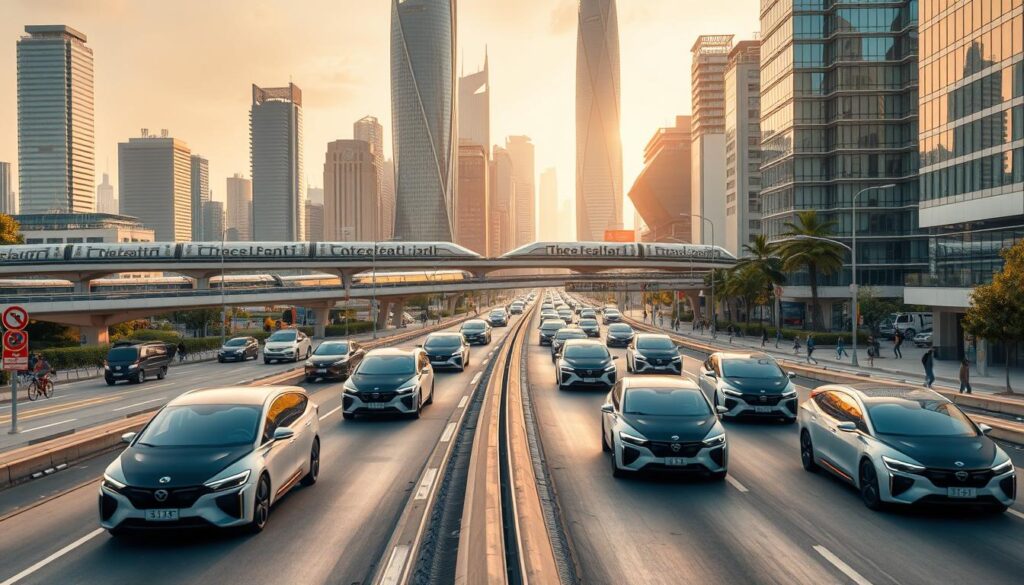As urban populations continue to grow, a pressing question arises: How can cities accommodate the increasing demand for efficient and sustainable commuting? The answer lies in embracing smart city transport solutions that leverage technology to reduce congestion, lower emissions, and enhance travel times.
According to a recent U.N. report, the transportation sector accounts for approximately one-quarter of global greenhouse gas emissions. By integrating advanced technologies, cities can significantly mitigate this impact. For insights into the engineering behind these solutions, visit transportation network engineering resources.
Key Takeaways
- Efficient commuting is crucial for urban development and sustainability.
- Smart city transport solutions reduce congestion and lower emissions.
- Advanced technologies, including IoT and big data, play a pivotal role in optimizing transportation networks.
- Public transit systems are essential for efficient commuting.
- High-speed rail and advanced public transit can significantly enhance commuting efficiency.
What Are Smart City Transport Solutions?
As cities grow, the need for smart city transport solutions becomes more pressing to manage the complexities of urban mobility. Smart city transport solutions involve the integration of advanced technologies to manage and optimize transportation systems, making urban commuting more efficient and sustainable.
Definition and Overview
Intelligent Transportation Systems (ITS) are a crucial component of smart city transport solutions. ITS apply a variety of technologies to monitor, evaluate, and manage transportation systems, enhancing efficiency and safety. This includes real-time data tracking, smart traffic management, and integrated public transport systems.
The core objective of smart city transport solutions is to create a sustainable urban mobility framework that reduces congestion, lowers emissions, and improves the overall quality of life for citizens.
Importance for Urban Planning
Smart city transport solutions play a vital role in urban planning by providing data-driven insights to city planners. This enables them to make informed decisions about infrastructure development and transportation management.
- Enhancing mobility and accessibility for all citizens
- Reducing traffic congestion through intelligent traffic management
- Promoting sustainable modes of transport
By adopting smart city transport solutions, cities can create a more efficient, sustainable, and livable urban environment. The importance of these solutions lies in their ability to transform urban mobility and address the challenges posed by rapid urbanization.
Key Features of Smart Transport Solutions
Connected urban transportation is at the forefront of creating efficient commuting systems. Smart transport solutions are designed to make urban mobility more efficient, sustainable, and responsive to the needs of citizens.
Real-time Data Tracking
One of the key features of smart transport solutions is real-time data tracking. This involves the use of IoT devices and 5G communication technology to monitor and manage transportation systems in real-time. By leveraging real-time data, cities can optimize traffic flow, reduce congestion, and improve the overall commuting experience.
The integration of IoT devices enables the collection of data on various aspects of transportation, including traffic volume, speed, and incidents. This data is then analyzed to identify patterns and trends, allowing cities to make informed decisions about transportation planning and management.
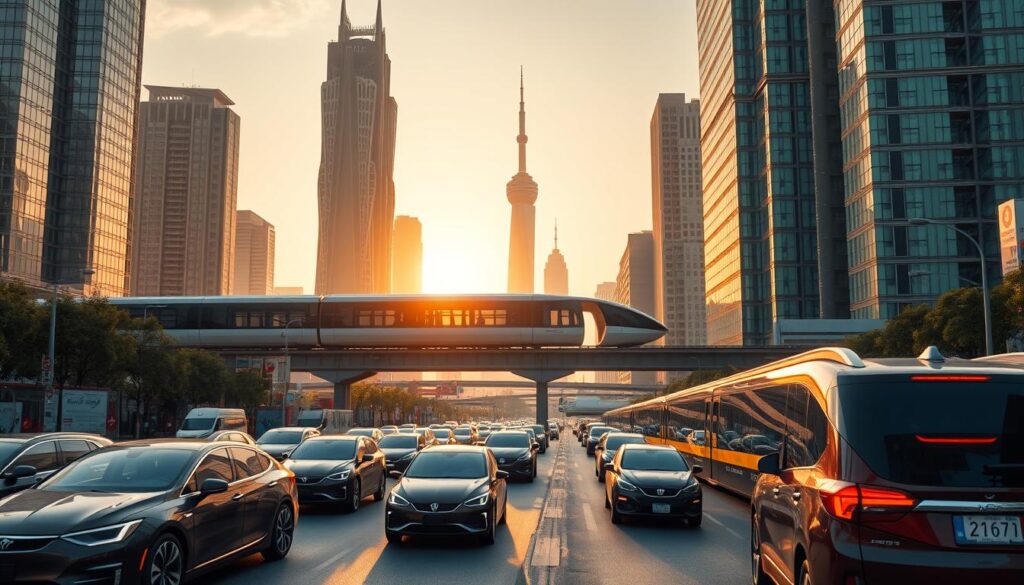
Integration of Technologies
Another critical feature of smart transport solutions is the integration of various technologies. This includes the integration of data analytics, artificial intelligence, and communication technologies to create a cohesive and responsive transportation network.
| Technology | Application | Benefit |
|---|---|---|
| IoT Devices | Real-time data collection | Improved traffic management |
| 5G Communication | High-speed data transmission | Enhanced connectivity |
| Data Analytics | Traffic pattern analysis | Informed decision-making |
By integrating these technologies, cities can create a connected urban transportation system that is efficient, sustainable, and responsive to the needs of citizens.
Benefits of Smart City Transport Systems
Smart mobility solutions are at the forefront of transforming transportation in urban areas, making it more accessible and efficient. By leveraging advanced technologies, cities can significantly enhance the commuting experience for their residents.
Enhanced Mobility and Accessibility
One of the primary benefits of smart city transport systems is the enhancement of mobility and accessibility. Real-time data tracking allows for more efficient routing and scheduling, making public transport a more attractive option for commuters. Additionally, smart mobility solutions can be tailored to meet the needs of all citizens, including those with disabilities, by providing accessible and reliable transportation options.
For instance, cities can implement intelligent traffic signals that adjust their timings based on real-time traffic conditions, reducing congestion and decreasing travel times. Moreover, the integration of various transport modes through smart mobility solutions enables seamless transfers between different types of transport, further enhancing mobility.
Reduction in Traffic Congestion
Smart city transport systems also play a crucial role in reducing traffic congestion. By optimizing traffic signal timings and providing real-time traffic information, cities can minimize congestion and reduce travel times. According to recent data, smart transportation systems can reduce traffic congestion by up to 20% by optimizing traffic signal timings and providing real-time traffic information.
| Benefits | Description | Impact |
|---|---|---|
| Enhanced Mobility | Real-time data tracking and optimized routing | Increased accessibility for all citizens |
| Reduced Congestion | Intelligent traffic signals and real-time traffic information | Decreased travel times and reduced congestion |
| Improved Efficiency | Integration of various transport modes | Seamless transfers between different types of transport |
In conclusion, the benefits of smart city transport systems are multifaceted, ranging from enhanced mobility and accessibility to a significant reduction in traffic congestion. By embracing smart mobility solutions, cities can create a more efficient, sustainable, and livable urban environment.
Popular Technologies in Smart Transport
Urban transport innovation is being driven by the integration of advanced technologies. Cities worldwide are leveraging these technologies to create more efficient, sustainable, and user-friendly transport systems.
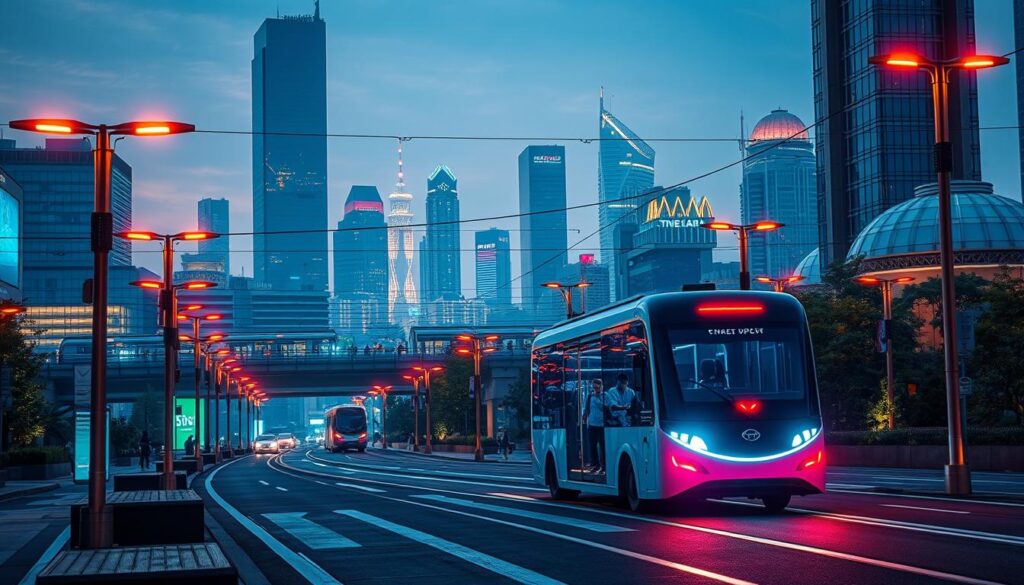
Intelligent Traffic Management Systems
Intelligent Traffic Management Systems (ITMS) are a crucial component of smart transport. These systems utilize real-time data and advanced analytics to optimize traffic flow, reduce congestion, and minimize travel times. For instance, cities like Kansas City, Missouri, have implemented smart traffic management systems, resulting in reduced traffic delays and improved public transportation.
According to IoT For All, intelligent transportation systems are pivotal in making transportation smart. They enable cities to respond dynamically to traffic conditions, thereby enhancing the overall efficiency of the transport network.
Automated Public Transport Systems
Automated Public Transport Systems are another significant aspect of urban transport innovation. These systems involve the use of autonomous vehicles and smart infrastructure to provide reliable and efficient public transportation. By minimizing the need for human intervention, automated systems can reduce operational costs and enhance safety.
As noted by World Civil Society, engineering the future of transport involves tackling grand challenges, including the integration of automated systems into existing transport networks.
The benefits of these technologies are multifaceted:
- Improved traffic management through real-time monitoring and analytics
- Enhanced safety features in automated public transport
- Increased efficiency and reduced operational costs
- Better user experience through smart ticketing and information systems
As cities continue to adopt and integrate these technologies, the future of urban transport looks increasingly promising, with potential for significant improvements in mobility, sustainability, and quality of life.
Role of Big Data in Transport Solutions
The application of big data analytics is transforming the landscape of urban transport. By harnessing the power of data, cities can create more efficient, sustainable, and eco-friendly city transportation systems.
Big data plays a crucial role in transport solutions, enabling cities to analyze traffic patterns and predict future demand. This is achieved through advanced data analytics and machine learning techniques.
Data Analytics for Traffic Monitoring
Data analytics is being used to monitor traffic in real-time, helping cities to manage congestion and reduce travel times. This involves analyzing data from various sources, including traffic sensors, GPS devices, and social media feeds.
Some of the key benefits of using data analytics for traffic monitoring include:
- Improved traffic flow and reduced congestion
- Enhanced safety through real-time incident detection
- More accurate traffic forecasting
Predictive Modeling for Demand Forecasting
Predictive modeling is used to forecast demand for transportation services, enabling cities to plan and optimize their transport infrastructure. This involves analyzing historical data and using machine learning algorithms to predict future trends.
The benefits of predictive modeling for demand forecasting include:
- Better planning and optimization of transport resources
- Improved efficiency and reduced waste
- Enhanced passenger experience through more reliable services
To illustrate the impact of big data on transport solutions, consider the following comparative analysis:
| Transport Aspect | Traditional Approach | Big Data Approach |
|---|---|---|
| Traffic Monitoring | Relying on manual counts and limited sensors | Real-time data analytics from multiple sources |
| Demand Forecasting | Based on historical trends and limited data | Predictive modeling using extensive data sets |
By embracing big data, cities can create more efficient, sustainable, and eco-friendly transportation systems, ultimately enhancing the quality of life for their citizens.
Benefits of Autonomous Vehicles in Cities
The integration of autonomous vehicles into city transport systems is a significant step towards digital urban mobility. By leveraging autonomous technology, cities can create a more responsive and efficient transportation network.

Safety Improvements
One of the primary benefits of autonomous vehicles is the potential for significant safety improvements. Autonomous vehicles are equipped with advanced sensors and AI technology that enable them to detect and respond to their environment more effectively than human drivers. This can lead to a reduction in accidents caused by human error, such as distracted driving or speeding.
Moreover, autonomous vehicles can be programmed to follow traffic rules and regulations consistently, further enhancing safety on the roads.
Increased Efficiency
In addition to safety improvements, autonomous vehicles can also contribute to increased efficiency in urban transportation. By optimizing traffic flow and reducing congestion, autonomous vehicles can help decrease travel times and improve the overall commuting experience.
Furthermore, the use of autonomous vehicles can lead to better utilization of road infrastructure, potentially reducing the need for extensive road expansions or new constructions.
In conclusion, the integration of autonomous vehicles into urban transport systems is a crucial step towards achieving digital urban mobility. With benefits ranging from safety improvements to increased efficiency, autonomous vehicles have the potential to revolutionize the way we commute in cities.
Sustainable Transport Solutions
Sustainable transport solutions are not just a trend; they’re a necessity for modern urban planning. Cities are increasingly looking for ways to reduce their environmental impact while maintaining efficient transportation systems.
By leveraging smart city transit technologies, cities can create a more sustainable and efficient transportation system. This involves adopting innovative solutions that not only reduce emissions but also enhance the overall commuting experience.
Electric Vehicle Adoption
One of the key components of sustainable transport solutions is the adoption of electric vehicles (EVs). EVs offer a cleaner alternative to traditional fossil fuel-based transportation, significantly reducing greenhouse gas emissions.
Cities are promoting EV adoption by investing in charging infrastructure and offering incentives to residents and businesses. This shift not only benefits the environment but also improves air quality, making cities healthier places to live.
Car-sharing Programs
Another important aspect of sustainable transport solutions is the implementation of car-sharing programs. These programs allow multiple users to share vehicles, reducing the overall number of cars on the road and decreasing congestion.
Car-sharing programs also promote more efficient use of resources, as they encourage the use of vehicles that are more environmentally friendly. By integrating car-sharing with public transport systems, cities can create a seamless and sustainable transportation network.
In conclusion, sustainable transport solutions like electric vehicle adoption and car-sharing programs are crucial for creating a more eco-friendly urban environment. By embracing smart city transit technologies, cities can pave the way for a more sustainable future.
The Impact of Public Transport Innovations
As cities continue to grow, public transport innovations play a crucial role in shaping the future of urban transportation. By leveraging intelligent transportation systems, cities can create a more efficient and responsive transportation network.
Public transport innovations, such as smart ticketing systems and mobile apps for commuters, are improving the commuting experience for residents. These innovations make it easier for people to get around, reducing the reliance on personal vehicles and decreasing congestion.
Smart Ticketing Systems
Smart ticketing systems are revolutionizing the way people pay for public transport. With the use of contactless payments and mobile wallets, commuters can quickly and easily pay their fares. This not only reduces wait times but also makes the overall travel experience more convenient.
- Easy to use contactless payment options
- Reduced wait times at ticket counters
- Integration with mobile apps for a seamless experience
For more information on how smart cities are leveraging public transport, visit Be Smart City’s blog on smart cities and urban.
Mobile Apps for Commuters
Mobile apps are becoming increasingly popular among commuters, providing real-time information and enhancing the travel experience. These apps offer a range of features, including journey planning, live updates, and service alerts.
- Real-time journey planning and tracking
- Live updates on service disruptions
- Personalized travel recommendations
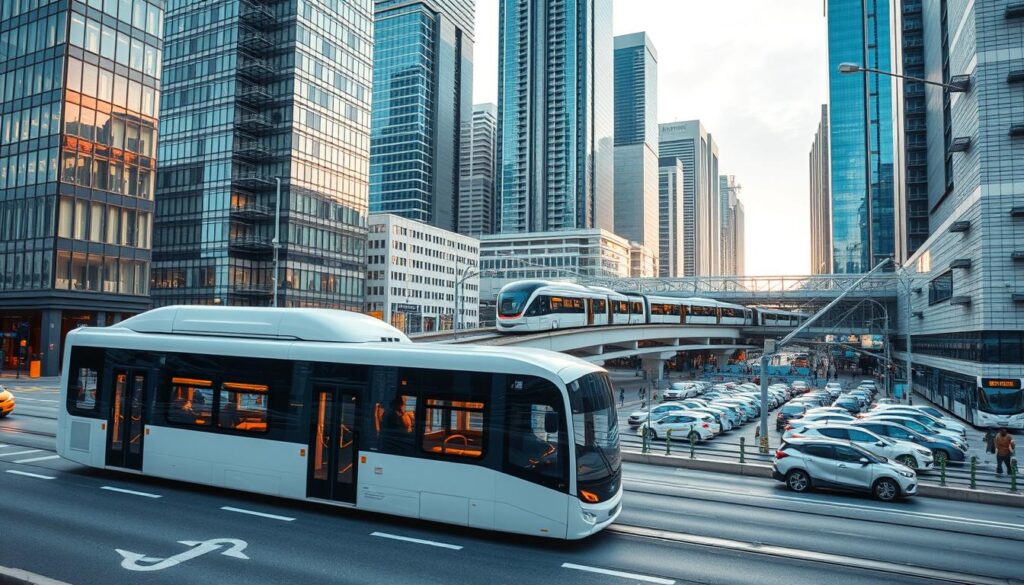
By adopting these smart city transport solutions, cities can improve the overall efficiency of their public transport systems, making them more attractive to residents and visitors alike.
Challenges in Implementing Smart Transport
Despite the benefits, smart transport faces numerous implementation challenges. Cities around the world are grappling with how to effectively integrate these systems into their existing infrastructure.
One of the primary challenges is related to infrastructure limitations. Many cities have outdated transportation infrastructure that is not compatible with the advanced technologies required for smart transport.
Infrastructure Limitations
The lack of modern infrastructure hinders the adoption of smart transport solutions. For instance, the absence of widespread high-speed internet connectivity and data analytics platforms can significantly impede the implementation of real-time traffic management systems.
- Inadequate public Wi-Fi coverage
- Limited data storage and processing capabilities
- Insufficient sensor technology for traffic monitoring
Addressing these infrastructure limitations is crucial for achieving sustainable urban mobility. Cities must invest in upgrading their infrastructure to support the integration of smart transport technologies.
Funding and Investment Concerns
Another significant challenge is securing the necessary funding and investment. Implementing smart transport systems requires substantial financial resources, which can be a barrier for many cities.
“The high upfront costs associated with smart transport technologies can deter cities with limited budgets.” – Urban Transport Expert
To overcome funding concerns, cities can explore public-private partnerships and seek out grants and subsidies that support the development of connected urban transportation systems.
- Identify potential funding sources
- Develop a robust business case for investment
- Foster partnerships with technology providers and investors
By addressing both infrastructure limitations and funding concerns, cities can make significant strides towards implementing effective smart transport solutions.
Case Studies of Successful Smart Transport Cities
Urban transport innovation is being driven by cities such as Barcelona and Singapore through their smart transport initiatives. These cities have implemented various smart mobility solutions that have significantly improved their transportation systems.
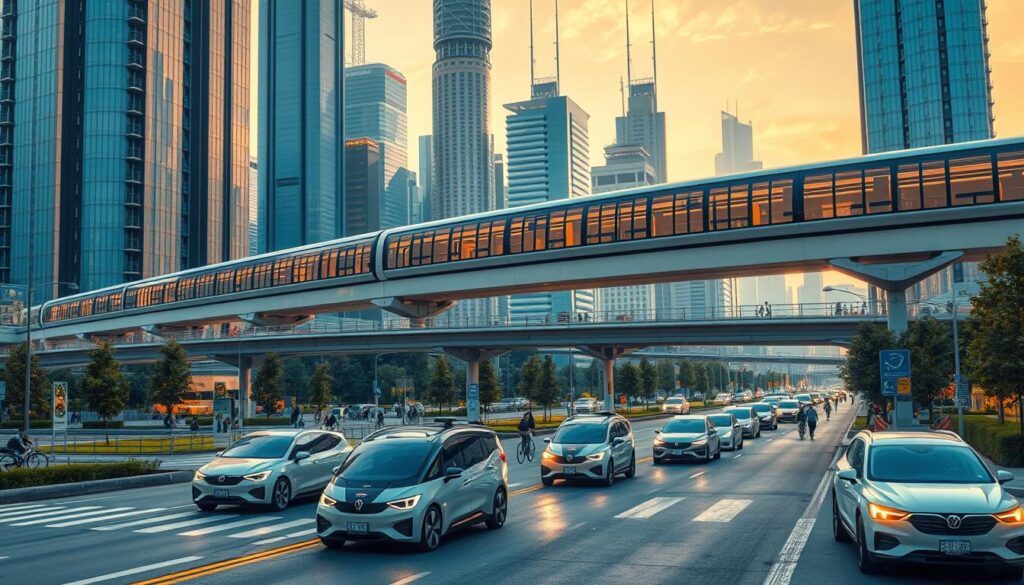
Barcelona’s Smart Transportation Initiatives
Barcelona has been at the forefront of implementing intelligent transportation systems. One of their notable initiatives is the integration of real-time data tracking into their public transport system, allowing for more efficient commutes and reduced congestion.
“The city’s approach to smart mobility is centered around creating a more livable and sustainable environment for its citizens.”
Some key features of Barcelona’s smart transportation initiatives include:
- Optimized traffic light control
- Real-time information systems for public transport
- Smart parking solutions
| City | Initiative | Impact |
|---|---|---|
| Barcelona | Smart Traffic Management | Reduced congestion by 20% |
| Barcelona | Real-time Public Transport Info | Improved commute times by 15% |
Singapore’s Integrated Transport Systems
Singapore is renowned for its integrated transport systems, which combine various modes of transport into a seamless network. This has been achieved through the use of advanced technologies and data analytics.
Some of the key aspects of Singapore’s transport system include:
- Intelligent transport management systems
- Comprehensive public transport networks
- Incentives for the use of public transport
Singapore’s approach to urban transport innovation has resulted in a highly efficient and reliable transport system, making it a model for other cities.
Collaborations Between Public and Private Sectors
Effective collaborations between the public and private sectors are pivotal in driving the implementation of smart transport solutions. By combining their expertise and resources, cities can create more efficient, sustainable, and user-friendly transportation systems.
Partnerships with Tech Companies
Partnerships with tech companies are revolutionizing urban mobility. These collaborations bring cutting-edge technologies to the forefront, enabling cities to adopt innovative solutions such as intelligent traffic management systems and real-time data analytics. For instance, a report by the World Economic Forum highlights the potential of public-private partnerships in enhancing smart city initiatives, including transportation. You can read more about this in their primer on public-private collaborations.
“Public-private partnerships are essential for leveraging the strengths of both sectors to drive innovation and efficiency in smart city transport solutions.”
Community Engagement Initiatives
Community engagement is another critical aspect of successful smart transport initiatives. By involving citizens in the planning and development process, cities can ensure that their transport solutions meet the actual needs of the community. This can be achieved through public forums, surveys, and digital engagement platforms.
For example, cities can use mobile apps to gather feedback from commuters, helping to identify areas for improvement and measure the effectiveness of new transport solutions. This not only enhances the user experience but also fosters a sense of community ownership over the transport infrastructure.
| Initiative | Description | Benefits |
|---|---|---|
| Partnerships with Tech Companies | Bringing innovative technologies to urban mobility | Enhanced efficiency, reduced congestion |
| Community Engagement | Involving citizens in transport planning | Improved user satisfaction, tailored solutions |
By embracing collaborations between the public and private sectors, cities can accelerate the development of eco-friendly city transportation and digital urban mobility solutions. This collaborative approach is key to creating smart transport systems that are not only efficient but also sustainable and responsive to the needs of the community.
Future Trends in Smart City Transport
Emerging trends in smart city transport are transforming the urban transportation landscape, offering more efficient, accessible, and environmentally friendly options. As cities continue to grow and evolve, the need for innovative transport solutions becomes increasingly important.
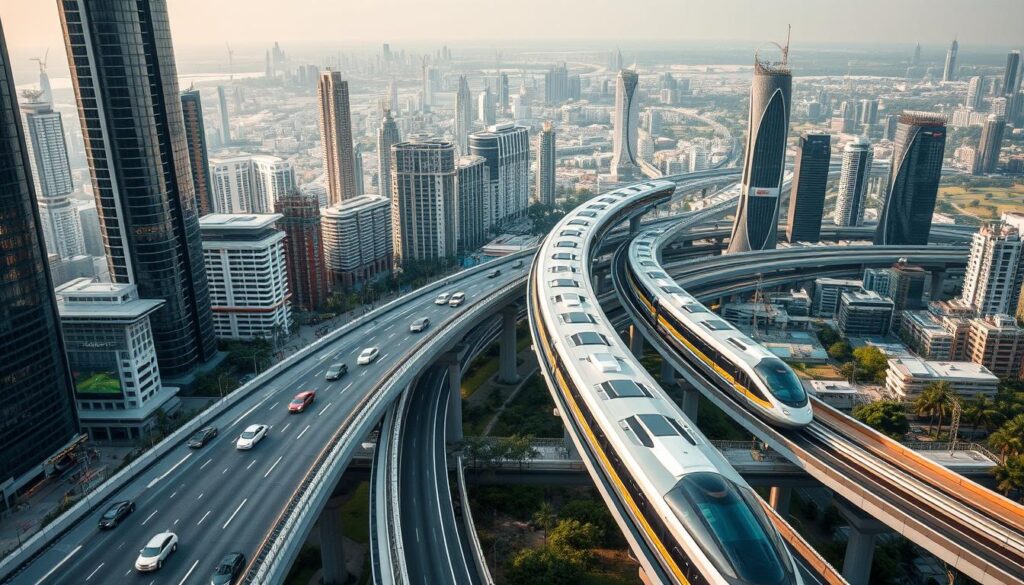
The future of smart city transport is likely to be shaped by several key trends. One of the most significant is the expansion of Mobility-as-a-Service (MaaS), which integrates public, private, and shared transportation services into a single, convenient platform. This approach not only enhances mobility but also reduces reliance on personal vehicles, thereby decreasing congestion and pollution.
Expansion of Mobility-as-a-Service (MaaS)
MaaS platforms are revolutionizing the way people move around cities by providing a seamless, user-centric experience. By combining different modes of transport, such as buses, trains, car-sharing, and bike-sharing, MaaS makes it easier for commuters to choose the most efficient and cost-effective options for their journeys.
Growth of Micromobility Options
Another trend shaping the future of smart city transport is the growth of micromobility options, including e-bikes, e-scooters, and other lightweight, electric vehicles. These modes of transport are not only environmentally friendly but also provide a flexible and affordable alternative for short-distance travel, reducing the need for cars in urban areas.
As smart city transit technologies continue to advance, we can expect to see even more innovative solutions emerge. By embracing these trends, cities can create a more sustainable, efficient, and responsive transportation network that meets the needs of their citizens.
Policy Considerations for Smart Transport
As cities evolve into smart cities, policy considerations play a pivotal role in shaping their transport systems. Effective smart transport solutions demand a comprehensive understanding of these policy considerations to ensure the creation of intelligent transportation systems that promote sustainable urban mobility.
Regulatory Frameworks
A well-structured regulatory framework is crucial for the successful implementation of smart transport initiatives. This involves creating policies that support the integration of new technologies and innovations in transport, such as autonomous vehicles and smart traffic management systems. According to a study on smart transportation systems, regulatory frameworks can significantly impact the adoption rate of new transport technologies by facilitating or hindering their deployment.
Safety Standards and Compliance
Safety is a paramount concern in the development of smart transport systems. Ensuring that these systems comply with stringent safety standards is essential for protecting the public and fostering trust in new transport technologies. This includes implementing robust safety protocols for autonomous vehicles and ensuring that smart traffic management systems can respond effectively to emergencies.
By prioritizing policy considerations, including regulatory frameworks and safety standards, cities can create smart transport systems that are not only efficient and innovative but also safe and sustainable. This holistic approach is key to achieving sustainable urban mobility and enhancing the quality of life for urban residents.
How to Get Involved in Smart Transport Initiatives
Smart transport initiatives rely heavily on community participation to create effective and connected urban transportation systems. By engaging with local governments and participating in community programs, residents can contribute to the development of smart mobility solutions.
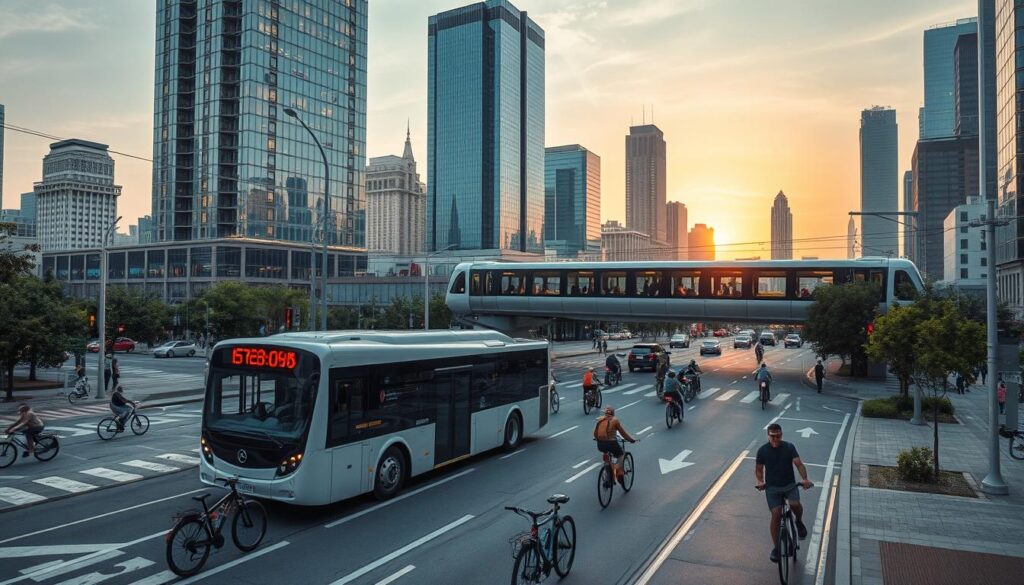
Engaging with Local Governments
One of the primary ways to get involved in smart transport initiatives is by engaging with local governments. Many cities have dedicated departments or initiatives focused on improving transportation systems. Residents can:
- Attend public meetings to provide feedback on proposed transport projects.
- Participate in surveys and online forums to share their opinions on transportation needs.
- Join local transportation committees or working groups to collaborate with city officials.
For more information on how to engage with local governments, you can visit the U.S. Department of Transportation’s Smart City page.
Participating in Community Programs
Community programs play a vital role in shaping smart transport initiatives. Residents can participate in various programs, such as:
- Car-sharing schemes that promote the use of shared vehicles.
- Bike-sharing programs that encourage cycling as a mode of transport.
- Public transport improvement initiatives that aim to enhance the efficiency and accessibility of public transport.
By participating in these programs, residents can help create more sustainable and efficient smart mobility solutions that benefit the entire community.
Final Thoughts on Smart City Transport Solutions
The future of urban mobility is being reshaped by smart city transport solutions, focusing on building resilient communities through innovation. As cities continue to evolve, embracing urban transport innovation is crucial for creating more efficient, responsive, and sustainable transportation systems.
Creating a Sustainable Future
Eco-friendly city transportation plays a vital role in reducing the environmental impact of urbanization. By adopting green technologies and promoting eco-friendly transport options, cities can significantly decrease their carbon footprint.
Resilient Communities Through Innovation
Smart city transport solutions not only improve the efficiency of transportation systems but also contribute to building resilient communities. By leveraging technology and innovation, cities can create a better future for their residents, enhancing their quality of life and promoting sustainable development.
